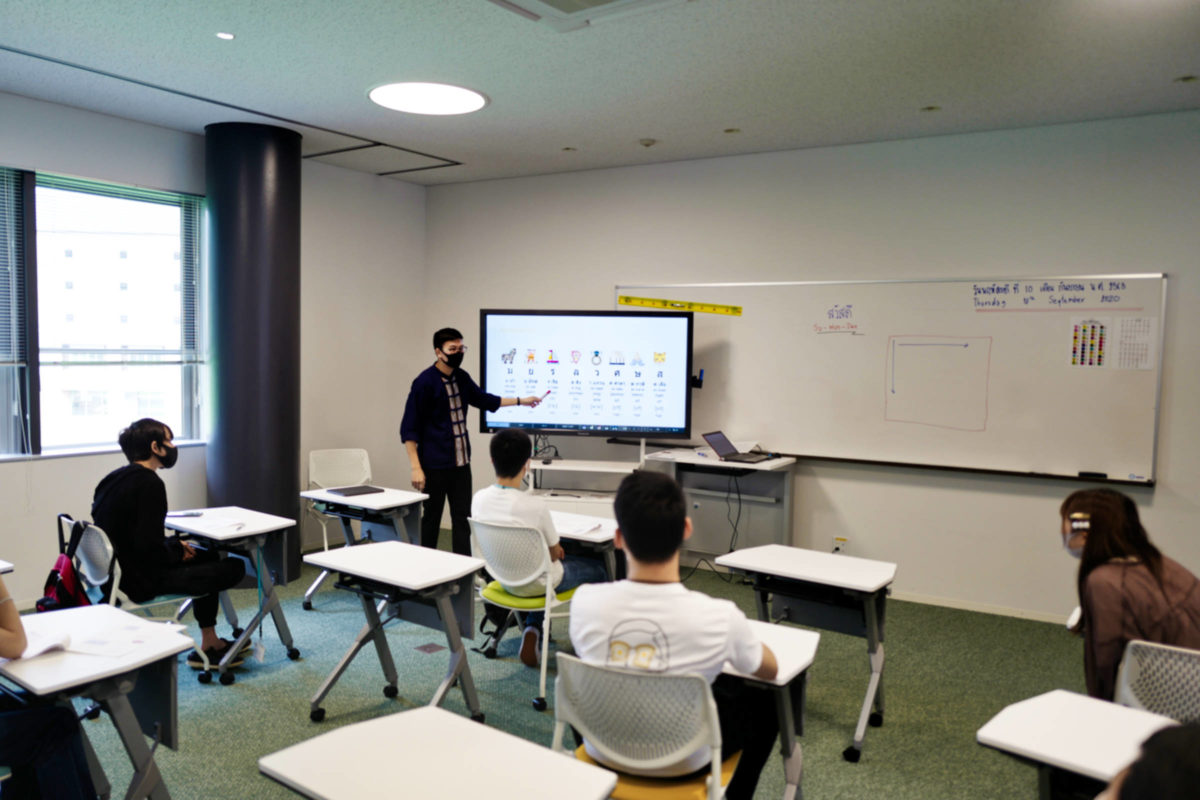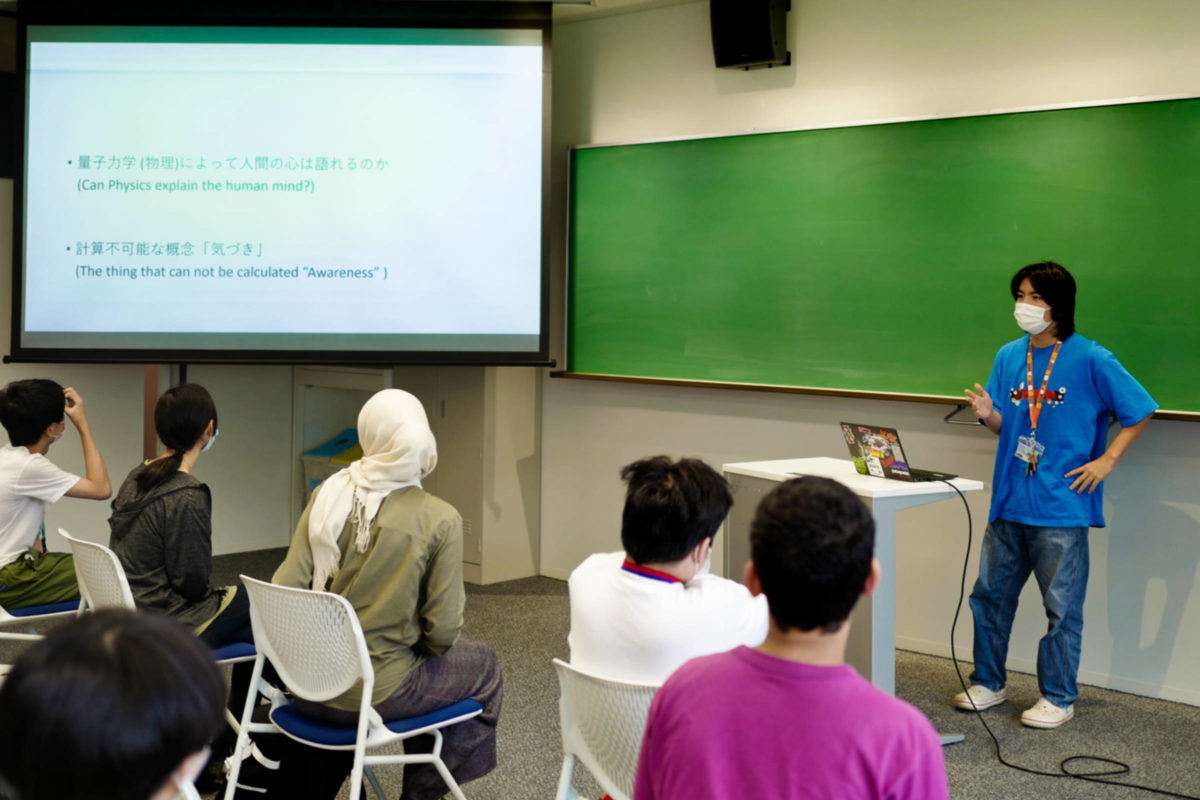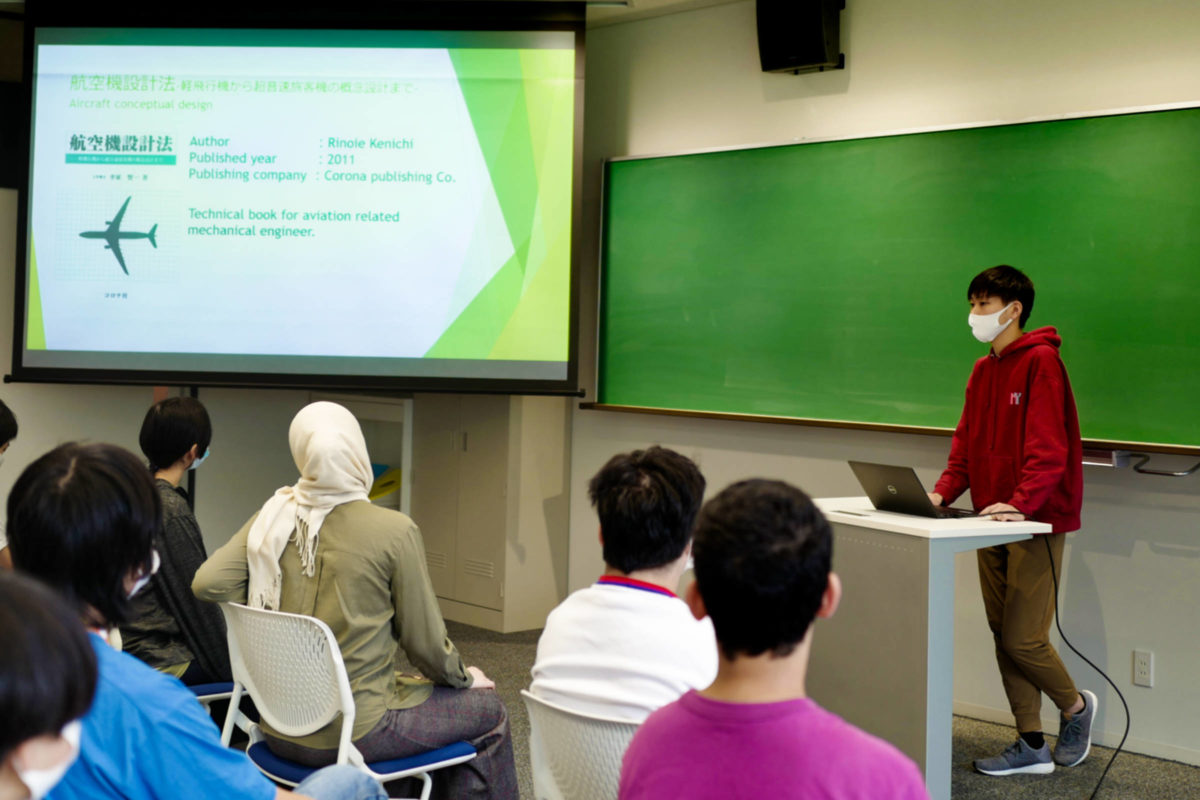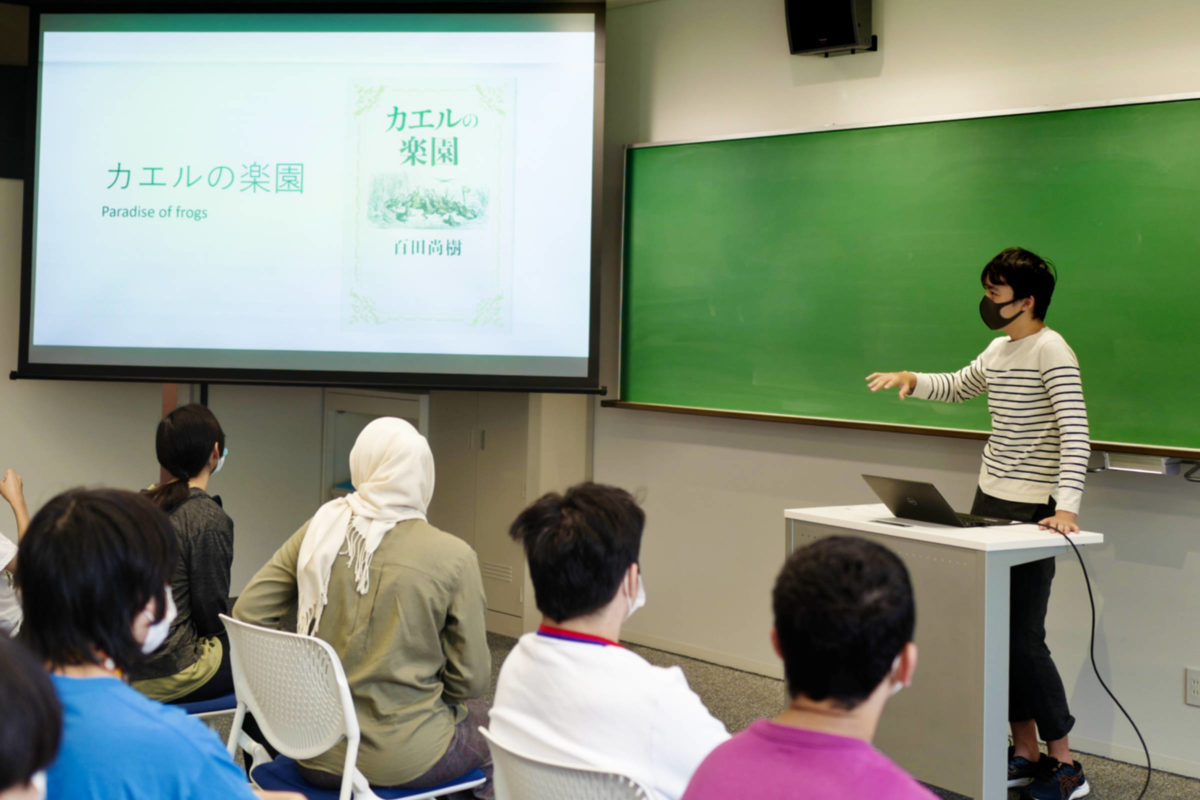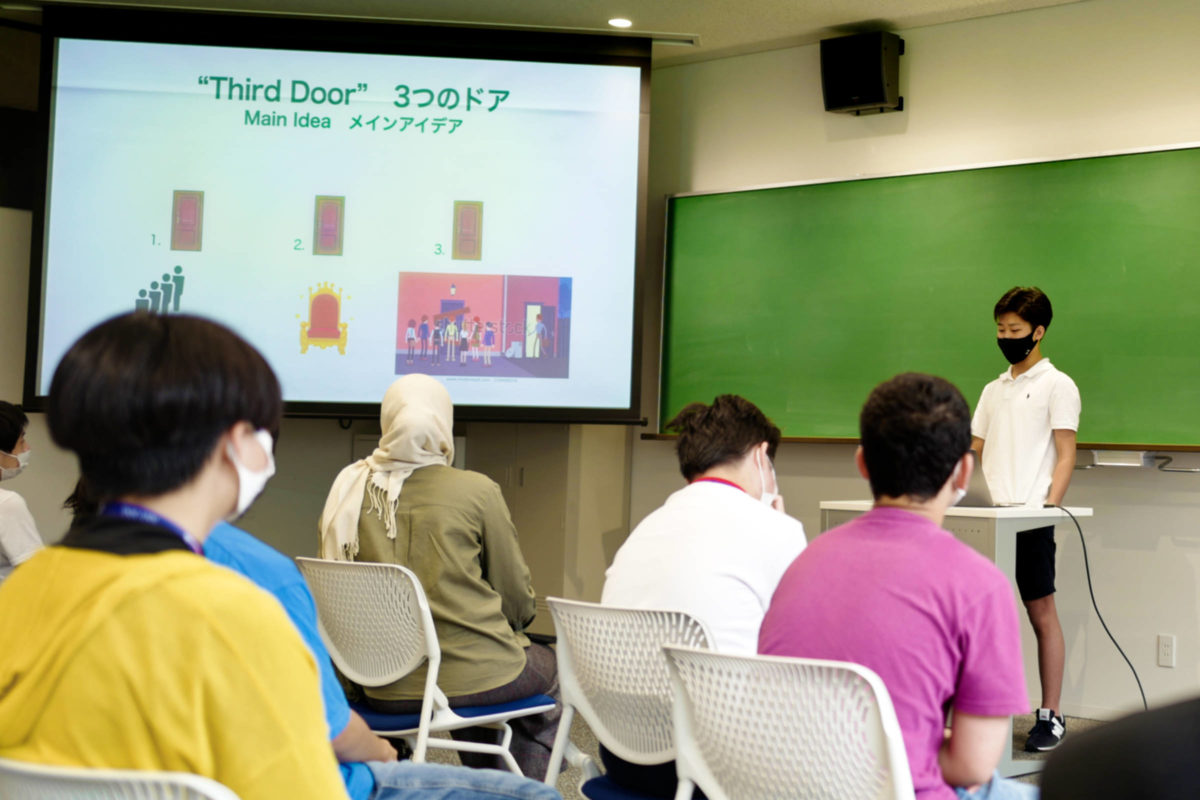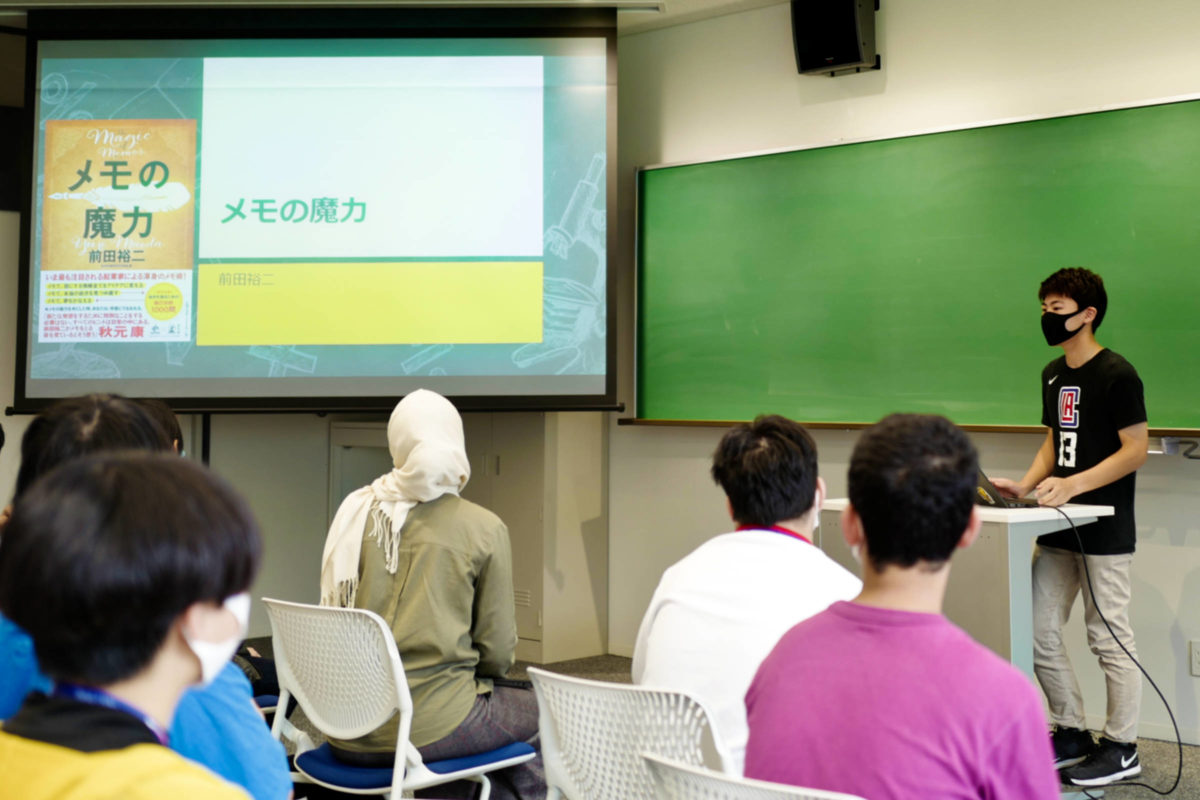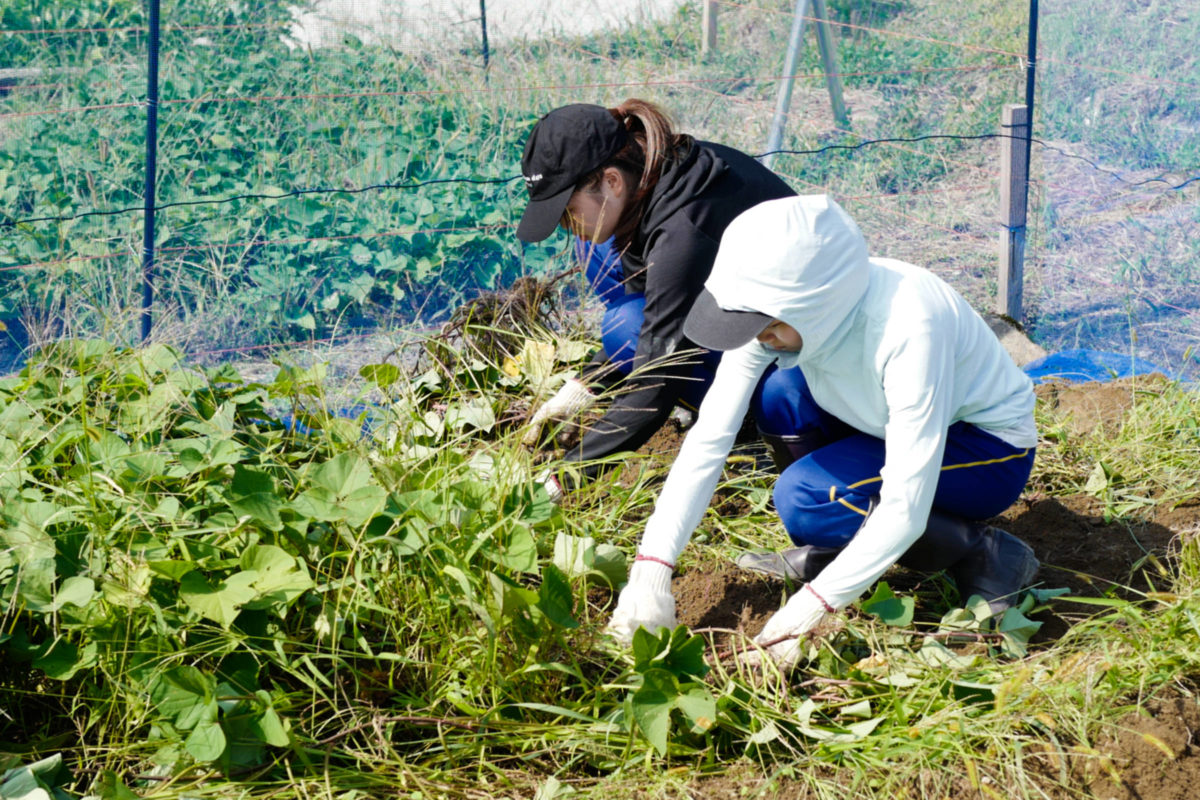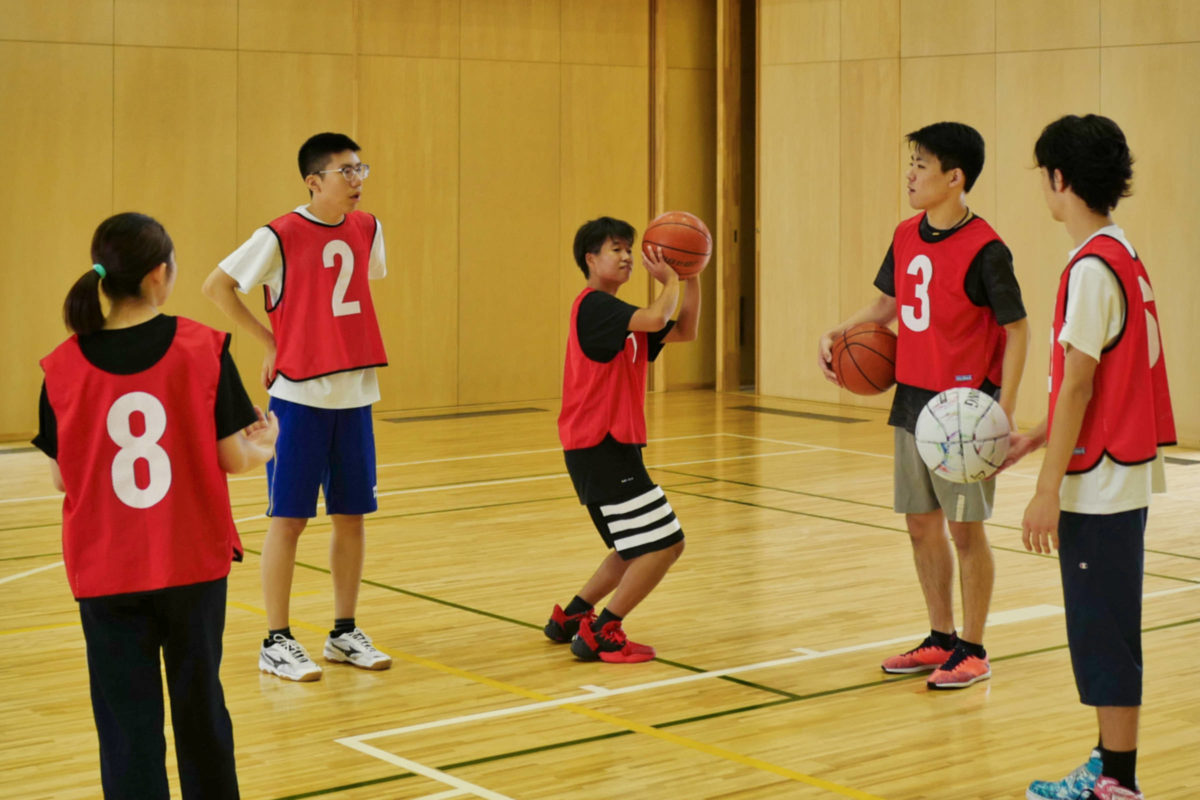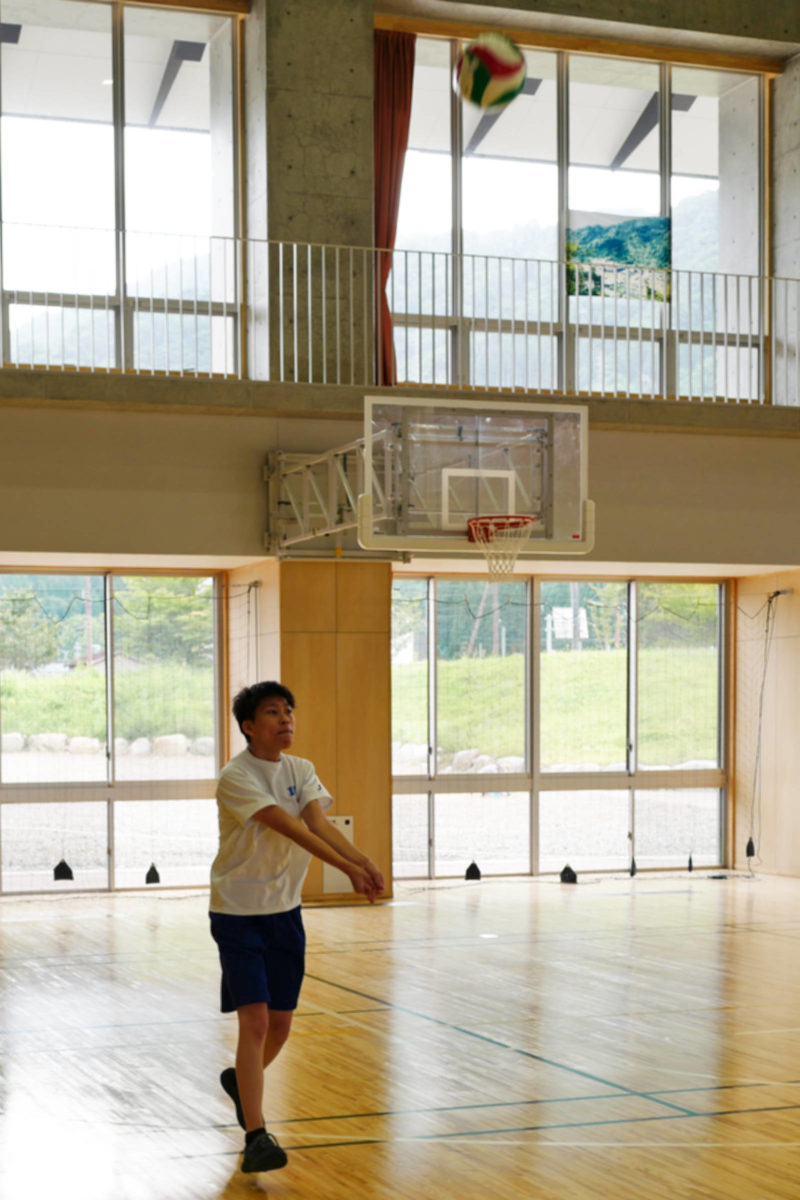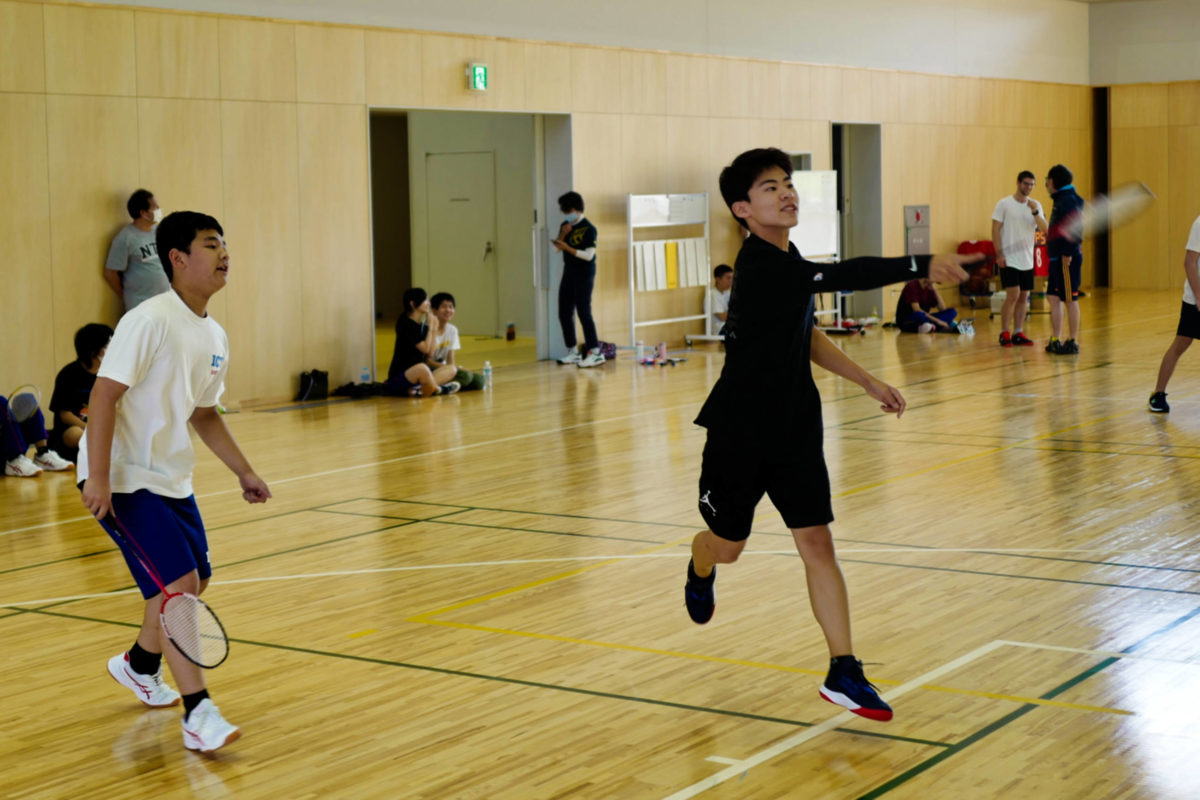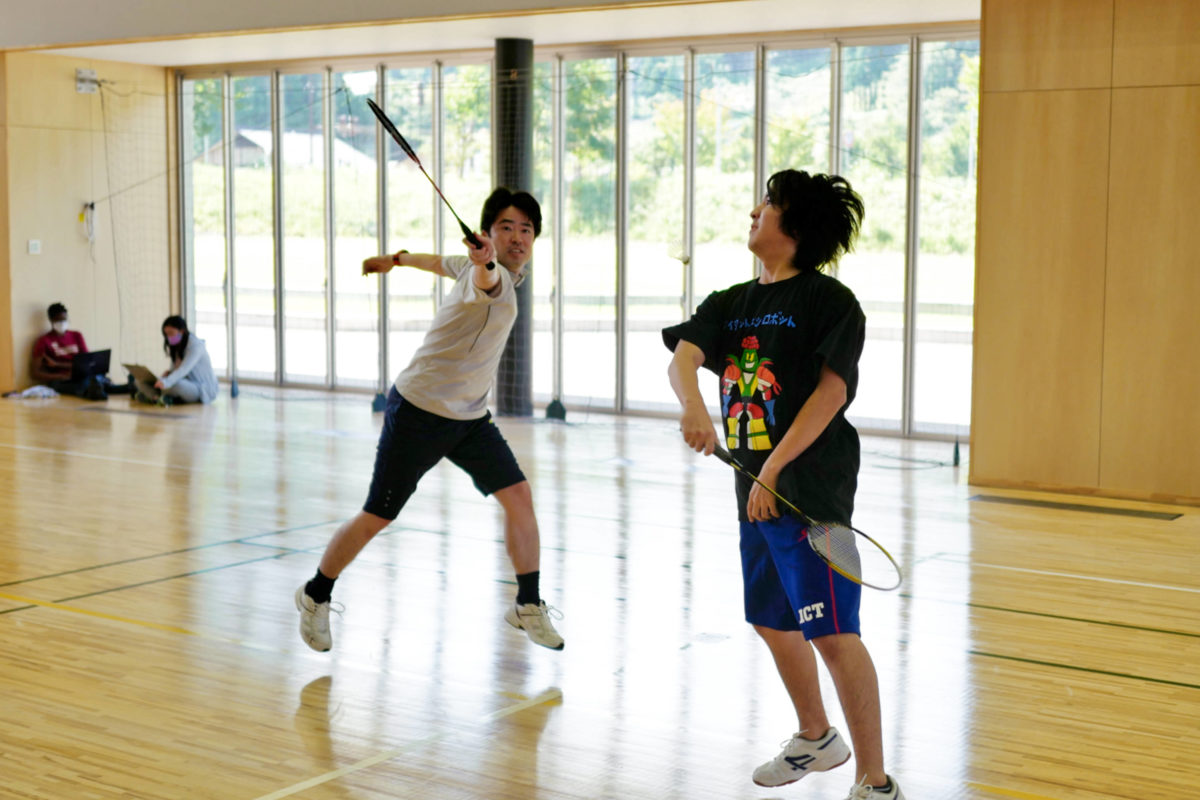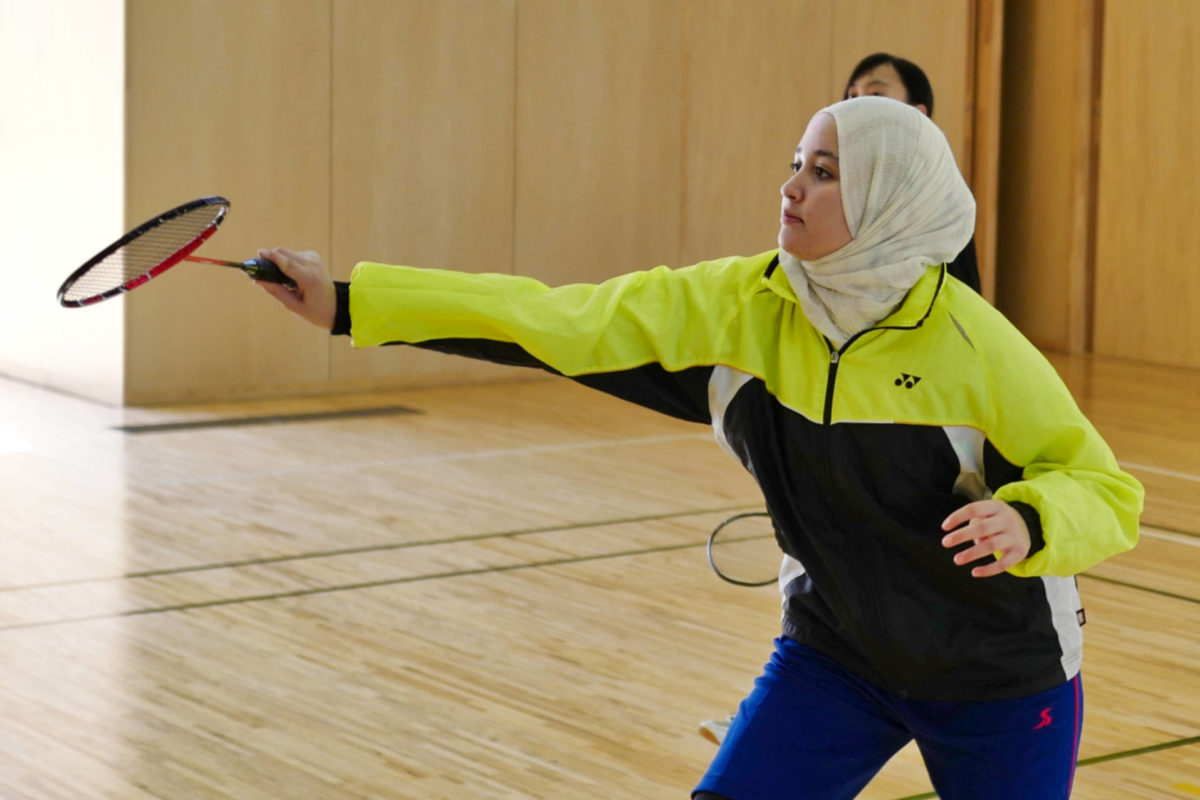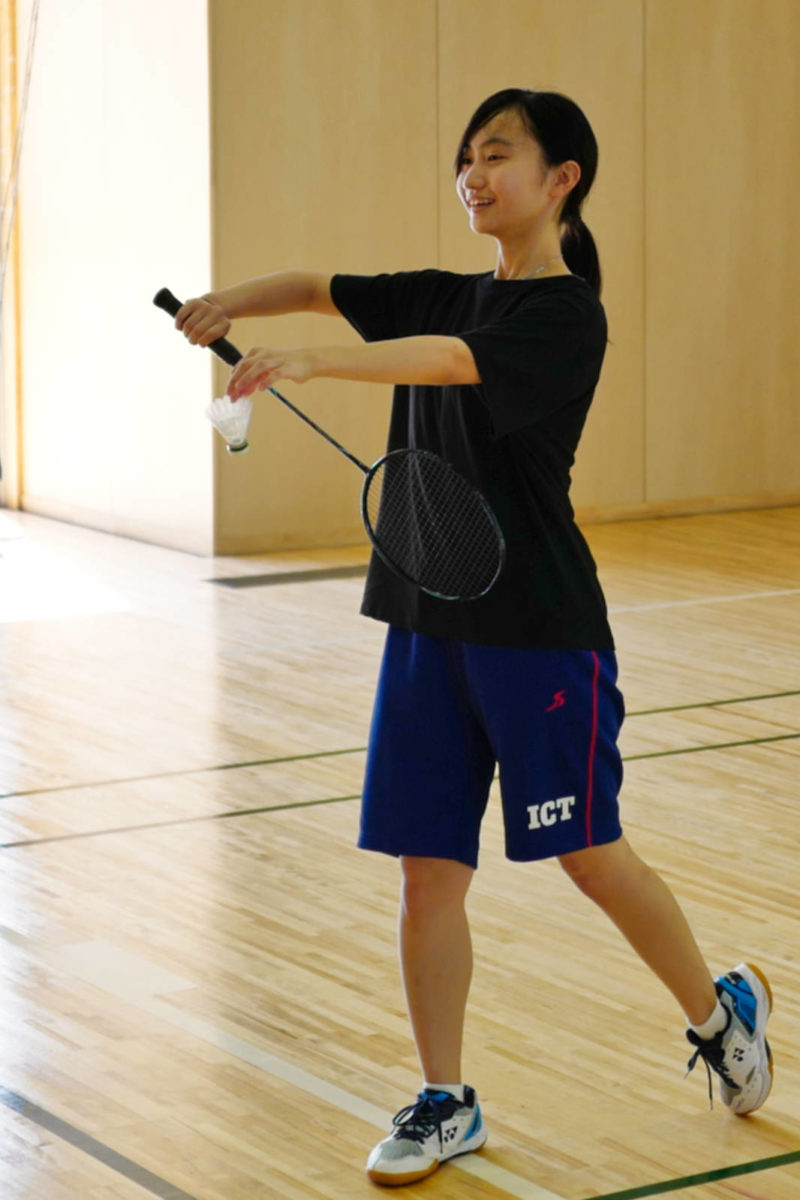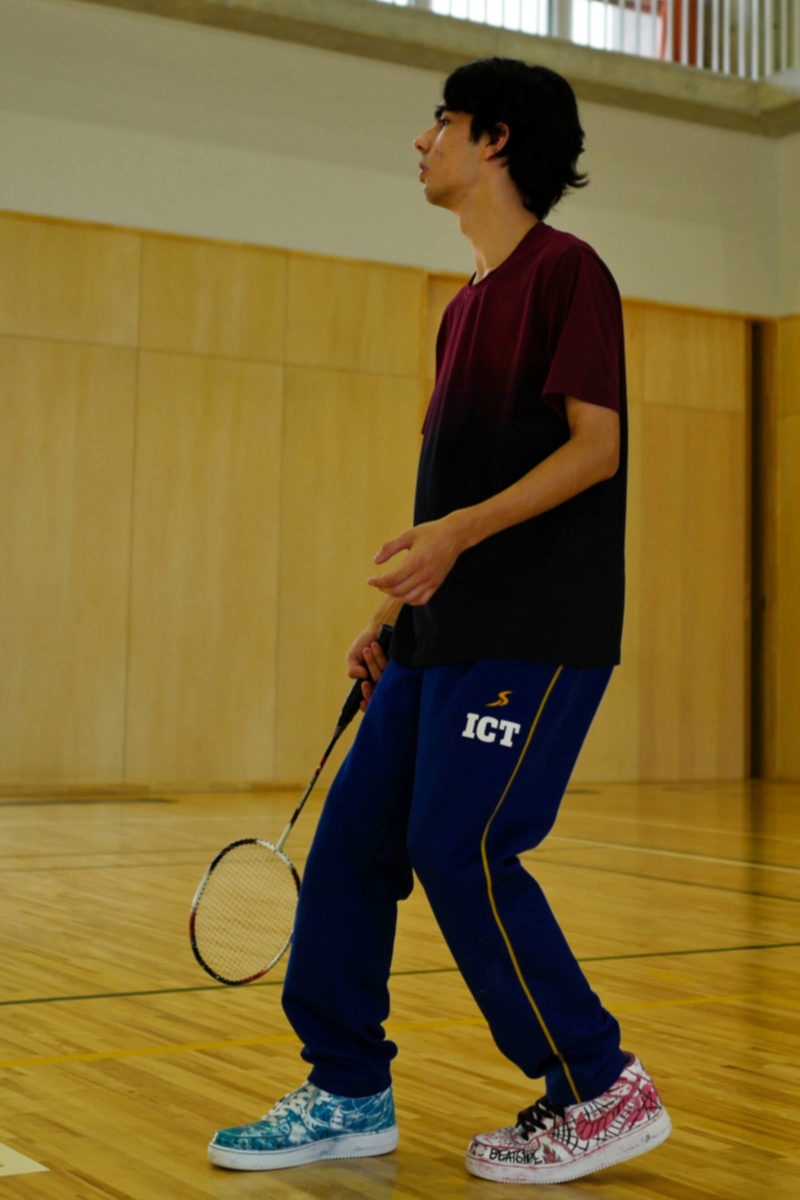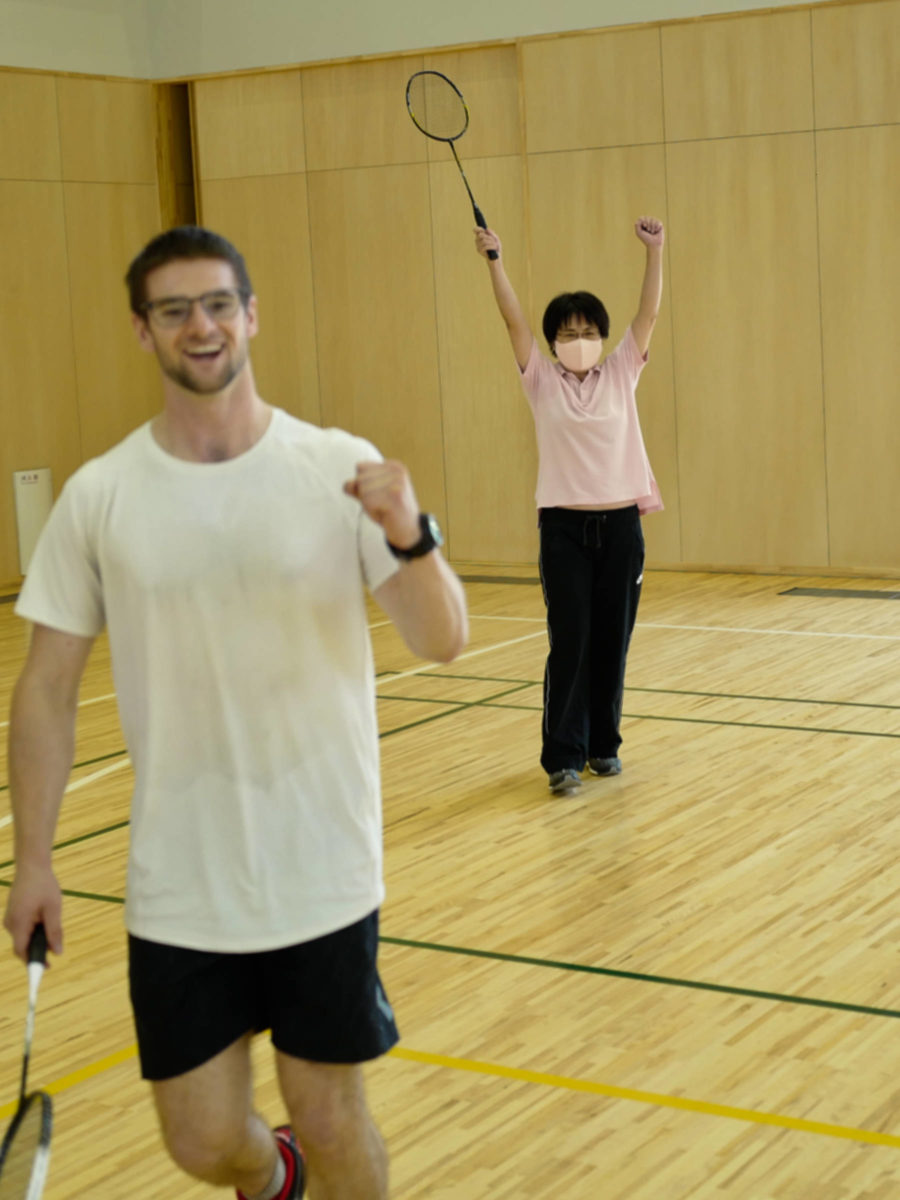Hakusanroku Journal 白山麓ジャーナル: 2020年9月の記事
September 30, 2020
 秋来ぬと目にはさやかに見えねども風の音にぞおどろかれぬる
秋来ぬと目にはさやかに見えねども風の音にぞおどろかれぬる
(秋が来たと目にははっきりと見えないけれど、風の音で気づいたよ。)
古今和歌集 秋歌上 藤原敏行
こんにちは。国語科のKTBです。猛暑の夏がやっと終わり、朝晩には涼しい風を感じます。白山麓では秋風に乗って舞い降りてきたアサギマダラの、藤袴の蜜を求める華麗なワルツが今年も見られるようになりました。夏は白山の室堂辺りで涼んでいるのだそうです。


9月22日には公民館主催のマーキング調査会が開催され、ICTからは山崎俊太郎先生と事務局の渡邊晶子さん、そして私の3名が参加しました。昨年度までICTの学生寮のRAを勤めていらした山下和樹さんが公民館からお世話に来てくださいました。


解説はアサギマダラファンクラブ白山代表の中村明男さん。右奥が山下和樹さん。
マーキング調査とは、旅する蝶アサギマダラが、どのようなコースを、どれくらいの日数をかけて、どこまで飛んでいくのか、などを調べるために、捕まえて、羽にマーク(標識)を付けて放し、遥か海の向こうで再び誰かに捕まえてもらうというものです。去年はこの白山でマーキングした蝶が2頭(蝶は「頭」で数えます。珍しい昆虫なども飼育している西洋の動物園でのheadという数え方がその由来だそうですが。)、台湾まで飛んだそうですよ。
マーキングの方法は、虫取り網でまずはアサギマダラを捕らえます。手で触ると死んだふりをして動かなくなるので、羽に油性ペンで、白山(捕獲場所)・9.22(日付)・YK(私のイニシャル)・01(何番目に捕獲したものか)と記入します。私は9時から11時までで5頭の捕獲に成功しました。マーキングを終えると写真を撮ります。しばらくすると死んだふりをやめて、再び藤袴の蜜を求めて飛び立ちます。

死んだふりをして手を離しても動かないアサギマダラ(5頭目)。下羽に黒い斑点があるのは雄です。どこまで飛んでいくのかしら。がんばれよ。じゃあまたね。
潟辺豊
秋来ぬと目にはさやかに見えねども風の音にぞおどろかれぬる
You cannot tell to the eye that autumn has come, but I suddenly noticed it by the sound of the wind.
Kokin-waka-shu Fijiwara-no-Toshiyuki
Hello, it's your Japanese teacher, KTB. Finally the scorching summer has ended and I can feel the cool breeze in the morning and evening. At Hakusanroku, it's the season when the chestnut tiger butterflies arrive on the autumn wind and dance around the thoroughwort flowers. I hear they spend the hot season near Mt. Hakusan's pear.
The annual marking investigation event hosted by the community center was held on September 22 and Shuntaro Yamazaki sensei, Shoko Watanabe san from the office, and myself participated from ICT. We also met our former RA, Kazuki Yamashita san there.
Akio Nakamura san, Hakusan representative of the Chestnut Tiger Butterfly Fan Club gave an explanation. You can see Kazuki Yamashita san standing on the right.
Marking investigation is the measurement of how far a butterfly travels, what route it takes, and how many days it takes. You catch a butterfly and release it after marking its wings. Then, someone on the other side of the ocean will find it. Last year two butterflies marked here were found all the way in Taiwan.
To mark a chestnut tiger butterfly, first catch one with a net. They will play dead once you touch them so write "Hakusan" (place), 9.22 (date), YK (my initials), and 01 (number of butterfly you caught). I caught five butterflies between 9 and 11 am. After you are done, take a picture. Soon they will stop playing dead and fly away in search of more thoroughwort nectar.
The third picture is the fifth Chestnut Tiger butterfly I caught playing dead. Males have black patch on bottom wing. Don't know where you're going, but safe travels. Hope to see you again.
Yutaka Katabe
September 28, 2020 Some of the things students have been doing in September
 Hi! It's Jonathan, the camera man. Today I would like to briefly talk about some of events that happened during September. Students returned to the Hakusanroku Campus between late August and early September. However, classes did not begin until the 24th. Instead, there were several special events organized as we waited for the two weeks to confirm the lack of COVID-19 to pass. (There was none, thank god.)
Hi! It's Jonathan, the camera man. Today I would like to briefly talk about some of events that happened during September. Students returned to the Hakusanroku Campus between late August and early September. However, classes did not begin until the 24th. Instead, there were several special events organized as we waited for the two weeks to confirm the lack of COVID-19 to pass. (There was none, thank god.)
こんにちは、ジョナサンです!2020年9月の白山麓キャンパスで行われたイベントをいくつか紹介したいと思います。1,2年生は8月の終わりから9月頭にかけて白山麓キャンパスに戻ってきましたが、授業が開始されるのは24日です。その間は新型コロナウィルス対策として2週間の自粛期間として特別活動期間に設定されました。(感謝すべきことに戻ってきた学生たちの中に感染者はいませんでした)
World Language
On September 10, several teachers organized a special class to teach languages "other than English". This special class was titled "World Language" and students could choose two languages from Arabic, Malay, Thai, and French. Teachers native to these languages taught the basic alphabet, some common phrases, how to write your name, and other interesting things depending on the teacher. The Arabic class was conducted by Nagwa sensei and Alaa sensei, the Malay by Hazwan sensei, Thai by Apirak sensei, and French by Jason sensei.
ワールドランゲージ
9月10日(火)、外国教員による英語以外の外国語特別講座「ワールドランゲージ」が実施され、1、2年生がアラビア語、マレー語、タイ語、フランス語から2つ選択して受講しました。講座では文字の読み書き、あいさつなどの簡単な話し言葉、名前の書き方など、担当教員によるオリジナリティ溢れる講座となりました。アラビア語講座はナグワ先生とアラー先生、マレー語講座はハズワン先生、タイ語講座はアピラク先生、フランス語講座はジェイソン先生によってそれぞれ行われました。
Book Review
On September 16, the first year students gave their book review presentations. Each student chose three books to read during the summer and give a brief presentation in English and Japanese. There were novels, how-to books, English books for beginners, and many unique books depending on the students' interests. All the presentations were extremely interesting, however we had to choose a "best book review" and so teachers and students voted on three presenters. You can see the first year students giving their presentations and the results in the pictures below.
ブックレビュー
9月16日(水)、1年生によるブックレビュー発表会が開催されました。学生たちは夏休みの間に読んだ本の中から3冊を選んで、日本語と英語を交えたプレゼンテーションを行いました。発表された本には小説、専門書、技術書、初心者向けの英語の本、画集など、学生たちの興味に合わせてさまざまな分野のものがあって大変面白かったです。担任の津田先生も「興味がある本を知ることで、君たちのことがもっと知れたようで嬉しかった」と語りました。また、「ベストブックレビュー」が学生と教職員の票によって選ばれました。発表の様子と上位3名は下の写真でご覧ください。
Sweet Potato Harvest
A group of second year students planted sweet potatoes as part of their Engineering Design project during the first semester. September marked the time for harvest. Actually, this is our second attempt at growing sweet potatoes. Last year, we were raided by the local monkey population just before harvest and lost 90% of our crop. To avoid the same outcome, students built a electrical fence and decided to harvest at the first signs of monkey attack. As a result we succeeded in collecting about 95% of this year's sweet potatoes. The four students of the group really got their hands dirty as they dug through the soil. You can see them and the sweet potatoes in the pictures below. These sweet potatoes will be branded, packaged, and sold by the students at local shops and farmer markets. I cannot wait to see what that will be like.
さつまいも「紅はるか」収穫
前学期のエンジニアリングデザインの活動として、国際高専の前にある畑にさつまいも「紅はるか」を植えた2年生のグループがいます。そのさつまいもがいよいよ収穫の時を迎えました。実は去年も同じようにさつまいもを植えた学生のグループがいましたが、猿の襲撃によって収穫のほとんどを奪われてしまいました。今年は対策として電気柵を設置し、猿が現れたら即座に収穫するという電撃作戦のおかげで植えたさつまいものうち、9割以上を収穫することができました。グループ4名の学生は手で土を掘って、芋を回収しました。下の写真でその様子を見ることができます。これらのさつまいもは学生がデザインしたブランド芋として包装されて、地元のスーパーやファーマーズマーケットで販売されます。去年の無念を乗り越えたさつまいもがどうなっていくのか、今後の活動が楽しみです。
Sports Day
On September 17 and 19, we held a special Hakusanroku Sports Day. This Sports Day event was organized by the P.E. teachers to give the students a chance to blow their steam from being crammed in isolation. Three teams: first year, second year, and teacher and staff, played against each other in basketball, volleyball, and badminton.
Basketball was a battle between the second year students and the teachers all star team. The teachers are much larger and more experienced. However, basketball is a popular free time activity among many of the second year students and they had secretly practiced leading up to this event. Teachers dominated the first half, but the second year team fought back and ended the exciting game with a draw of 8-8. Volleyball was also a close game between all three teams. Students enjoyed it so much that they created a student all star team to challenge the winning teacher and staff team after the tournament.
The badminton tournament was a twelve-round three-way competition. There were three courts and each team chose two pairs to compete each round. The winner would be the team with the most wins and the least losses. The great part of this system was that more people had the chance to play. Each team was hungry for the final victory, and each round was both competitive and fun to play and watch. In the end, the first and second year teams ended with the exact same points. Takimoto sensei was about to end the event with a draw, but the students insisted on a deciding match between the best two pairs. The second year students won this game and were declared the winners of the badminton portion.
Results:
Basketball: Second Year Team, Teacher and Staff Team (draw), First Year Team (3rd)
Volleyball: Teachers and Staff Team (1st), Second Year Team (2nd), First Year Team (3rd)
Badminton: Second Year Team (1st), First Year Team (2nd), Teachers and Staff Team (3rd)
The event was a great success and I heard many students remarking that they enjoyed it so much that they wished we could do it EVERY month.
スポーツデー
9月17日と19日の2日間、白山麓キャンパスのスポーツデーが開催されました。外界と隔離されている1、2年生が夏休みから戻ってから無事に2週間が経ち、PCR検査も全員陰性だったことを受け、我慢を乗り切った祝賀イベントとして学生・教職員対抗の球技大会が企画されました。競技はバスケットボール、バレーボール、バドミントンの3種目で、1年生、2年生、教職員の3チームが競い合いました。
バスケットボールは普段からプレイしている2年生チームと、技術と体格を兼ね備えた教職員チームが決勝で衝突し、激しい試合の末8対8の同点を迎えました。バレーボールはフルセットまで競う好勝負が続き、最後は優勝した教職員チームと1年生と2年生を混ぜたオールスターチームが競うエキシビション・マッチが行われました。
バドミントンはそれぞれのチームがダブルスを組んで12試合の総当たり戦を行いました。ほかの種目と異なり、それぞれのチームメンバーのほぼ全員が1度は出場をする総力戦となりました。最後は1年生と2年生チームが同率1位となり、決勝戦を制した2年生チームが優勝となりました。学生からは「楽しかった」「毎月やりたい」という声が相次ぎ、両学年と教職員の距離を縮める大成功となりました。
Voting Simulation
On September 18, the second year students participated in a voting simulation by the election association of Ishikawa prefecture and Hakusan city. Students first listened to Ms. Natsumi Nakao from the Ishikawa Election Committee talk about the importance of voting, laws of to voting and election campaigning, and the how the election system works. Afterwards, the students participated in a simulation where they considered the manifest of two imaginative candidates and went through the process of posting a vote. The simulation was quite realistic and hopefully gave the students a taste of deciding their representor in the future.
選挙講話
9月18日(金)、2年生対象の選挙講話が石川県選挙管理委員会、白山市選挙管理委員会、白山市明るい選挙推進協議会の協力によって行われました。まず、石川県選挙管理委員会の中尾夏美さんが、選挙の大切さ、投票や選挙運動の注意点、選挙の方法について話をしました。その後、本物の選挙さながらのシミュレーションが行われ、学生たちは架空の立候補者2名のマニフェストを吟味した上で、受付、記入、投票までの流れを体験しました。選挙の重要性を知って実際に体験することで、18歳になった時に納得が行く代表者選びができるようになることを願っています。
September 25, 2020 永光寺報告文
 令和2年9月5日(土)午前、3年生11名が必修科目「生活と文化」の一環として、担当教員の札野先生、ポーリン先生の引率のもと、石川県羽咋市にある洞谷山永光寺を訪問し、境内見学および参禅体験を行いました。
令和2年9月5日(土)午前、3年生11名が必修科目「生活と文化」の一環として、担当教員の札野先生、ポーリン先生の引率のもと、石川県羽咋市にある洞谷山永光寺を訪問し、境内見学および参禅体験を行いました。
洞谷山永光寺は、曹洞宗の太祖である瑩山紹瑾が正和元年(1312年)に開創した曹洞宗発展史上極めて重要な古刹です。幕末期の名工によって建てられたという白木造りの山門をくぐると、歴史を感じさせる荘厳な本堂を臨むことができます。学生たちは、ご住職に温かく迎えられた後、永光寺の歴史や座禅の作法についてお話を伺い、その後、文殊菩薩座像が安置された僧堂にて、一人ひとり間隔を空けて座り、30分ほど座禅をしました。
小川のせせらぎや小鳥のさえずりを感じながら、姿勢や呼吸を整えることで心を整えることを試み、短時間でしたが、貴重な体験となったようでした。ご住職との談話のなかで「心が清められました」と笑顔で語る学生や、「有意義だったと思う」と感想を述べた学生もいました。
「生活と文化」は、本来3年生がニュージーランドに留学している間、異文化を探究する科目です。しかし、今年はコロナ禍により留学が足止めされたため、その代わりに、できるだけ体験的に日本文化を学び、かつ海外の人から日本について質問された際にしっかりと答えられるよう、学習成果を外国人の先生に向けて発表し、議論するという取り組みを行っています。
今回も、事前学習として学務部長の宮野純光氏より世界の宗教や仏教についての講義を受け、9月17日(木)には、座禅の効能や日本人の宗教観など様々なトピックで、ゲストの外国人教員たちに英語でプレゼンテーションを行いました。オンライン参加したNZオタゴポリテクニクのネイサン先生からは、「食事の席では宗教や政治の話はしないのがマナーと言われるけれど、ニュージーランドでは一般的な内容なら誰も気にしないと思うよ」と教えていただき、終始アットホームな雰囲気のなか活発な質疑応答が飛び交いました。
学生たちは、念願だった留学に旅立つ数日前に足止めとなり、この半年、通常以上の心の葛藤と闘っているに違いありません。そのようなストレスと向き合うためにも、今回の参禅体験で学んだことを活かしてほしいと思っています。そして、このような体験学習を通じて日本文化について理解を深め、将来の異文化交流に役立ててもらいたいと考えています。今回は宗教(特に仏教)がテーマでしたが、次回以降は日本食(特に発酵食品)、芸能(伝統楽器)等を予定しています。
黒田 譜美
On the morning of September 5 (Sat) 2020, the eleven third-year students visited Tokoku-san Yokoji temple (洞谷山永光寺) in Hakui city Ishikawa along with their homeroom teachers Fudano sensei and Pauline sensei. They took a tour of the temple grounds and experienced Zen meditation as part of the class "Global Life and Culture".
Tokoku-san Yokoji is an ancient temple deeply connected with the history of the Soto school (曹洞宗) founded by Keizan-Jokin (瑩山紹瑾) in 1312. Passing through the white wood sanmon gate built by craftsmen in the late Tokugawa period, you will find yourself facing the majestic and historic main building of the temple. Students were warmly welcomed by the chief priest, who told us about the history of Yokoji temple and how to do Zen meditation. Then, the students were led to a monastery that contained the Buddhist statue Monju-Bosatsu (文殊菩薩座像) and meditated for about 30 minutes.
Listening to the trickling of water from a nearby stream and chirping of birds, while concentrating on one's posture and breathing to calm the mind was a new experience for the students, but definitely worthwhile. Several students spoke to the chief priest afterwards, remarking that their mind felt clearer and that the experience was a meaningful one.
Usually, "Global Life and Culture" is a class the third-year students take in New Zealand as part of the study abroad program to learn about foreign cultures. However, we are prevented from going to New Zealand due to COVID-19. Therefore, we decided to experience Japanese culture firsthand instead. The students also created a presentation and debate session for the foreign teachers as part of the program. Hopefully, this way they can answer any questions about Japanese culture asked to them in the future.
The students received a preview course about religion and Buddhism by Yoshimitsu Miyano. On September 17 (Thu), they gave their presentation on the topic of the "Benefits of Zen meditation and Japanese Views on Religion" to the foreign teachers in English. Nathan sensei, who joined us online from Otago Polytechnic in New Zealand commented "some people say that it is inappropriate to speak about religion or politics during a meal. However, I believe most families in New Zealand will not mind talking about the general subject." The rest of the QA and discussion was lively and fruitful.
The third-year students were deprived of their year at Otago Polytechnic only a few days before departure and I can only imagine the disappointment they experienced. I hope that the meditation gave them a hint of how to deal with similar stressful situations. In addition, I hope this was an opportunity for them to deepen their understanding of Japanese culture that they can refer to later when interacting in an international community. We covered religion in this class. The next scheduled topics include Japanese food (especially fermented food) and traditional music.
Fumi Kuroda
September 18, 2020 国際理工学科2年生対象第1回NZ留学説明会
 夏休みが終わり、全員元気に帰寮した特別時間割期間中の9月15日(火)10時より国際理工学科2年生対象に第1回令和3年度ニュージーランド留学説明会が実施された。現時点では、ニュージーランド政府による同国への外国人留学生の入国は制限されている状況だが、みんなで協力しながらしっかり準備を進めて、留学の可能性を引き寄せていきましょうとの話しの後、大学の留学支援課宮野氏から今後の準備として入学願書・ビザ申請書類・ホームステイのアンケート作成、大阪の病院での胸部X線・健康診断の受診、現地の銀行の口座開設を予定していること、そして授業料、渡航費用、保険、旅程についての説明があった。オークランド到着後2週間の自主隔離の項目が旅程に記載されていることが例年と大きく違うところだった。
夏休みが終わり、全員元気に帰寮した特別時間割期間中の9月15日(火)10時より国際理工学科2年生対象に第1回令和3年度ニュージーランド留学説明会が実施された。現時点では、ニュージーランド政府による同国への外国人留学生の入国は制限されている状況だが、みんなで協力しながらしっかり準備を進めて、留学の可能性を引き寄せていきましょうとの話しの後、大学の留学支援課宮野氏から今後の準備として入学願書・ビザ申請書類・ホームステイのアンケート作成、大阪の病院での胸部X線・健康診断の受診、現地の銀行の口座開設を予定していること、そして授業料、渡航費用、保険、旅程についての説明があった。オークランド到着後2週間の自主隔離の項目が旅程に記載されていることが例年と大きく違うところだった。
今後、10月21日(水)、11月4日(水)の説明会で入学願書、ビザ申請書類の作成が予定されている。
(大原しのぶ)

Students have safely returned from their summer vacation. At 10:00 am on September 15 (Wed), we held the first briefing session for studying abroad in New Zealand, for our second-year students who are scheduled to go in 2021. Currently, the New Zealand government has yet to open their gates to international students. However, I told the students that staying optimistic and preparing for the best will draw us good luck. Next, Mr. Miyano from the KIT International Affairs Office explained about the entrance documents, visa, homestay survey, x-ray test and health check in Osaka, opening a local bank account, school fee, travel fee, insurance, and the overall schedule. I biggest difference compared to our regular schedule was the addition of the two week quarantine period in Oakland.
The following sessions are on October 21 (Wed) and November 4 (Wed) where we will begin filling out the entrance documents and visa application documents.
Shinobu Ohara
September 16, 2020 Chemistry Portfolios
 At ICT, we apply active learning methods in our classes. Most of the time, people think that active learning takes place only when students are involved in group activities or discussions. However, active learning is a lot wider term that takes place when students are more engaged, involved in the learning process where they are responsible of developing skills and gaining knowledge. The role of educators in the active learning process is to create chances, facilitate the materials, and draw students’ interest into new topics.
At ICT, we apply active learning methods in our classes. Most of the time, people think that active learning takes place only when students are involved in group activities or discussions. However, active learning is a lot wider term that takes place when students are more engaged, involved in the learning process where they are responsible of developing skills and gaining knowledge. The role of educators in the active learning process is to create chances, facilitate the materials, and draw students’ interest into new topics.
In Chemistry classes, students are involved in the learning process in all different ways. Besides, taking notes, performing experiments, and take part in the class or group discussions, students are required to create their own portfolios. In Chemistry Portfolios, students need to include all the possible learning evidences, and journal entries that show how they reflect on their own learning process and gained skills. As I watch my students’ portfolios and read their entries, I learn more about my students as individual learners and people. While reading how they think about what was interesting, challenging, or new, I discovered that our roles as educators is to show our students the doors and give them the keys. Students then decide which door to open and discover a whole new world. I enjoyed reading what my students wrote in their entries. I took S2 students’ permission to pick some examples to share with you, and here they are.
Taketora wrote, “First thing that I was interested in was that water in solid state is less dense than in liquid state. Actually, I knew that, but I didn’t know why. Water molecules are polar bonded. When they form ice, they are arranged in hexagonal shape because polar forces attract and also repel water molecules. I understand why ice floats on water.”
Daiko wrote, “While studying Chemistry IIA, I felt that an understanding of chemistry is essential to understanding nature!”
Shuntaro wrote, “Also, that plasma is the fourth state of matter is new knowledge for me. I did not know about plasma because I never saw it before and the textbook in secondary school that only told me about 3 states of matter.”
Luca wrote, “In terms of learning skills, I have developed skills of getting used to the online learning system using zoom.”
Koutaro wrote, “The most shocking experience in Chemistry IIA was learning that there aren’t only three states of matter, but that there is another, plasma. I heard about a plasma cutter, but I never researched how it works and what the plasma is. Conclusively, Chemistry IIA was an enjoyable and very interesting subject for me. I believe Chemistry IIB will be even more interesting.”
Anna wrote, “I was very interested in experiments. I learned it is important to continue to study and chip away at studying.”
Mao wrote, “Whilst studying Chemistry IIA I have developed many learning skills and study habits that have helped me not only in chemistry but all other subjects. Taking Chemistry IIA has made me see that a lot of what we learn in class has relevance to the real world and are not just concepts for school. It was also interesting to see some of the concepts and ideas I learned as a first-year student intertwining and relating to some of the topics I learn as a second year.”
Miyu wrote, “I will never forget about the topic of particles because it has a relationship with the sunset’s color. I am curious about the sunset’s colors. I'll research more about this relationship during my STEM project 2020. Overall, I did my best this semester. The class was interesting and I learned a lot of new things. I will try everything next semester.”
Yoshiki wrote, “I believe there are lots of skills I have learned during the first semester. One of it is to read the textbook before the chemistry class and take notes about important words. Overall, during this semester, I learned a lot of things about the use of science in daily life, chemical reactions, chemical names, the states of matter, and so on. All of these topics are important for our future and our life.”
Yuudai wrote, “Lastly, I will never forget the information about the states of matter because it might be used in the future to distinguish things.”
Nagwa Fekri Rashed

化学のポートフォリオ
国際高専の授業では、アクティブラーニングを実践しています。アクティブラーニングはグループ活動やディスカッションの時にしか使えないと思われがちですが、アクティブラーニングは学生が積極的に授業に参加していて、能動的に技能を高めたり、知識を獲得したりする時に使用できる、もっと広い意味を持つ表現です。アクティブラーニング時の教師の役割は学生に学ぶ環境を整え、教材を用意し、新しいトピックへ興味を向けさせることです。
化学の授業では、学生は様々な手段で学習しています。ノートを取る、実験を行う、グループディスカッションに参加する以外に、学生たちはポートフォリオを作ります。化学のポートフォリオでは、学生は可能な限り学習エヴィデンスを残して、学習や上達したスキルについて振り返るジャーナルの記入が求められます。学生のポートフォリオを読むことで、学習する姿勢や内面を知ることができます。どんな授業内容を面白い、難しい、新鮮と感じるかどうかを読むことで、教育者として学生に扉を示して鍵を渡す役割を再確認します。学生は好きな扉を選んでまったく新しい世界を発見するのです。ジャーナルを読むのは本当に楽しいです。2年生の許可を得ていくつか載せますので、ぜひ読んでみてください。
武虎『最初に興味が湧いたのは固体の水が液体より密度が大きいということです。そのことは知っていましたが、理由がわかりませんでした。水の分子はポーラー結合です。氷になる時、polar forceが水の分子を引き寄せると同時にはじくので六角形の配置になります。氷が水に浮かぶ理由がわかりました。』
大虎『化学IIAを勉強していると、化学を学ぶということは自然の本質を理解することにつながると感じました!』
俊太朗『プラズマが物質の4番目の状態であることを初めて知りました。これまではプラズマを見たことがなかったし、中学の教科書には物質の状態は3種類と載っていました。』
瑠華『学習スキルの上達という意味では、Zoomを使ったオンライン授業に慣れてきました。』
晃太朗『化学IIAで1番驚いたのは物質の状態が3つだけではなく、プラズマという状態があることです。プラズマカッターは知っていましたが、その仕組みやプラズマが何なのかを調べたことがありませんでした。結果的に、化学IIAは楽しく学習できる面白い科目でした。化学IIBはもっと面白いだろうと期待しています。』
杏奈『実験が面白かったです。コツコツ勉強することの大切さを学びました。』
真央『化学IIAのために勉強することで、ほかの科目にも役立つ学習スキルや習慣を身に着けることができました。化学IIAを通して、教室で学ぶ内容は学校に留まらず、その後の人生に役立つことが実感できました。また、1年目に習ったいくつかの内容が2年目の学習に絡んでくるところが面白かったです。』
美結『夕日の色に関係しているので、粒子の勉強は忘れません。夕日の色に興味があるので、今年のSTEMプロジェクトでもっと詳しく調査します。振り返ると、今学期は最善を尽くしたと思います。授業は面白かったし、新しいことをたくさん学べました。来年もすべてのことに挑戦します。』
義基『前学期は色んな学習スキルを身に着けることができました。ひとつは化学の授業の前に教科書を読んで重要な単語をメモすることです。今学期は化学反応、化学薬品、分子の状態など、日常生活に役立つ化学をたくさん学びました。今後の人生に重要な内容だと思います。
祐大『最後に、分子の状態について学んだ内容は将来役立つと思うので忘れません。』
ナグワ・ラシィド
Hakusanroku Journal
Archive
- 2022年12月
- 2022年11月
- 2022年10月
- 2022年9月
- 2022年8月
- 2022年7月
- 2022年6月
- 2022年5月
- 2022年4月
- 2022年3月
- 2022年2月
- 2022年1月
- 2021年12月
- 2021年11月
- 2021年10月
- 2021年9月
- 2021年8月
- 2021年7月
- 2021年6月
- 2021年5月
- 2021年4月
- 2021年3月
- 2021年2月
- 2021年1月
- 2020年12月
- 2020年11月
- 2020年10月
- 2020年9月
- 2020年8月
- 2020年7月
- 2020年6月
- 2020年5月
- 2020年3月
- 2020年2月
- 2020年1月
- 2019年12月
- 2019年11月
- 2019年10月
- 2019年9月
- 2019年8月
- 2019年7月
- 2019年6月
- 2019年5月
- 2019年4月
- 2019年3月
- 2019年2月
- 2019年1月
- 2018年12月
- 2018年11月
- 2018年10月
- 2018年9月
- 2018年8月
- 2018年7月
- 2018年6月
- 2018年5月
- 2018年4月
- 2018年3月



